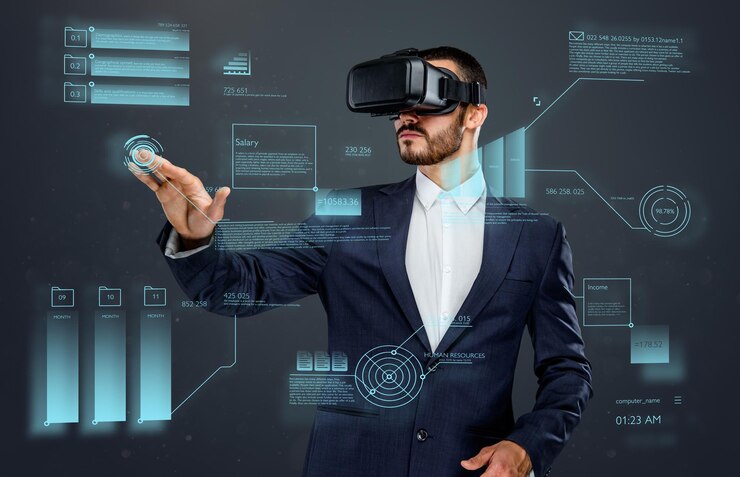
Introduction
Advancements in healthcare technology are revolutionizing patient care, diagnostics, and treatment modalities. This article explores the latest trends and innovations in healthcare technology, highlighting their impact on medical practices, patient outcomes, and the future of healthcare delivery.
Understanding Healthcare Technology
1. Definition and Importance
- Define healthcare technology and its role in improving healthcare access, efficiency, and quality.
- Importance of technology in enhancing diagnostics, treatment options, and patient monitoring.
2. Core Technologies
- Telemedicine and remote patient monitoring: Virtual care platforms and wearable health devices.
- Electronic health records (EHR) and interoperability for seamless healthcare information exchange.
Key Trends in Healthcare Technology
1. Artificial Intelligence (AI) in Healthcare
- AI-driven diagnostics, image analysis, and predictive analytics for personalized medicine.
- Applications in disease detection, treatment planning, and drug discovery.
2. Internet of Medical Things (IoMT)
- IoT devices and sensors for real-time health monitoring and chronic disease management.
- Smart healthcare devices improving patient adherence and health outcomes.
3. Robotics and Minimally Invasive Surgery
- Surgical robots and automation technologies enhancing precision and patient safety.
- Advancements in robotic-assisted surgery and recovery times.
Industry Applications of Healthcare Technology
1. Telehealth and Virtual Care
- Expansion of telehealth services, virtual consultations, and telemedicine platforms.
- Improving access to healthcare in rural areas and enhancing patient convenience.
2. Digital Health and Mobile Apps
- Health and wellness apps for fitness tracking, medication reminders, and lifestyle management.
- Integration with wearable devices and personalized health insights.
3. Medical Imaging and Diagnostics
- AI-powered medical imaging analysis for early disease detection and treatment monitoring.
- Enhancing radiology practices, pathology diagnostics, and patient outcomes.
Innovations and Emerging Technologies
1. Blockchain and Healthcare Data Security
- Blockchain applications for secure health data management, interoperability, and patient privacy.
- Ensuring data integrity and compliance with healthcare regulations.
2. 3D Printing in Healthcare
- Customized prosthetics, implants, and medical devices using additive manufacturing.
- Advancements in tissue engineering and personalized medicine applications.
Future Outlook and Challenges
1. Regulatory Landscape and Adoption
- Challenges in regulatory approval, healthcare IT integration, and interoperability standards.
- Adoption barriers and strategies for overcoming resistance to technology implementation.
2. Ethical Considerations and Patient-Centered Care
- Ethical dilemmas in AI-driven healthcare decisions, patient consent, and data ownership.
- Humanizing healthcare technology and prioritizing patient well-being in digital health solutions.
Conclusion
Healthcare technology continues to evolve, driving innovations that improve patient care, optimize workflows, and transform healthcare delivery. As technology advancements accelerate and healthcare systems adapt, the potential for enhanced medical outcomes and patient-centric care remains promising.
Outline for “Trending 5G Technology”
Trending 5G Technology: Redefining Connectivity and Communication
Introduction
5G technology represents the next generation of wireless communication, promising faster speeds, lower latency, and increased connectivity. This article explores the latest trends and applications of 5G technology, highlighting its impact across industries, from telecommunications to smart cities and beyond.

Understanding 5G Technology
1. Definition and Core Features
- Define 5G technology and its key features: high speed, low latency, and massive connectivity.
- Evolution from previous wireless technologies (4G LTE) and capabilities of 5G networks.
2. Infrastructure and Deployment
- Deployment of 5G infrastructure: small cells, millimeter wave spectrum, and network slicing.
- Global rollout and challenges in building robust 5G networks for urban and rural areas.
Key Trends in 5G Technology
1. Enhanced Mobile Broadband (eMBB)
- Faster download and upload speeds for multimedia content, video streaming, and gaming.
- 5G-enabled smartphones and consumer devices driving adoption and user experiences.
2. Internet of Things (IoT) and Smart Cities
- IoT sensor networks and smart devices leveraging 5G connectivity for real-time data analytics.
- Smart city solutions: Traffic management, public safety, and energy efficiency initiatives.
3. Industry 4.0 and Automation
- Industrial IoT (IIoT) and smart manufacturing: Remote monitoring, predictive maintenance, and automation.
- Applications in robotics, autonomous vehicles, and supply chain management.
Industry Applications of 5G Technology
1. Telecommunications and Mobile Networks
- Telecom operators deploying 5G networks for improved network capacity and reliability.
- Transition from 4G LTE to 5G: Network upgrades, spectrum allocation, and spectrum sharing.
2. Healthcare and Telemedicine
- Remote patient monitoring, telehealth consultations, and medical imaging using 5G connectivity.
- Enhancing healthcare access and emergency response systems with low-latency communications.
3. Media and Entertainment
- 5G-enabled streaming services, augmented reality (AR), and virtual reality (VR) experiences.
- Immersive content delivery and interactive entertainment applications.
Innovations and Emerging Technologies
1. Edge Computing and 5G Integration
- Edge computing platforms leveraging 5G for real-time data processing and low-latency applications.
- Edge AI applications: Autonomous vehicles, smart grid management, and industrial automation.
2. Security and Privacy in 5G Networks
- Challenges in cybersecurity, data protection, and privacy concerns with 5G technology.
- Implementing secure network architectures and encryption protocols.
Future Outlook and Challenges
1. Global Adoption and Regulatory Frameworks
- Collaboration among governments, telecom operators, and technology providers for global 5G standards.
- Regulatory challenges, spectrum auctions, and policy frameworks for 5G deployment.
2. Innovation and Beyond 5G
- Research and development in 6G technology: Future innovations and technological advancements.
- Potential applications in AI, quantum computing, and next-generation connectivity solutions.
Conclusion
5G technology is poised to revolutionize connectivity and communication, unlocking new opportunities for innovation, economic growth, and societal transformation. As 5G networks expand and applications diversify, the transformative impact on industries and daily life continues to evolve.
Outline for “Trending Automation Solutions”
Trending Automation Solutions: Transforming Industries with Intelligent Technologies
Introduction
Automation solutions are reshaping industries by streamlining processes, increasing efficiency, and reducing operational costs. This article explores the latest trends and innovations in automation technologies, highlighting their applications, benefits, and challenges across various sectors.
Understanding Automation Solutions
1. Definition and Types of Automation
- Define automation solutions and their role in replacing manual tasks with automated processes.
- Types: Robotic process automation (RPA), cognitive automation, and industrial automation.
2. Core Technologies
- AI and machine learning: Algorithms for decision-making, predictive analytics, and autonomous systems.
- Robotics and autonomous systems: Automated machinery, drones, and robotic assistants.
Key Trends in Automation Solutions
1. Industry 4.0 and Smart Manufacturing
- IoT sensors, IIoT platforms, and digital twins optimizing production efficiency and supply chain management.
- Predictive maintenance, quality control, and real-time data analytics in smart factories.
2. Intelligent Business Process Automation
- RPA platforms automating repetitive tasks, data entry, and workflow management.
- Integration with enterprise systems: ERP, CRM, and supply chain management solutions.
3. Autonomous Vehicles and Transportation
- Development of self-driving cars, autonomous trucks, and unmanned aerial vehicles (UAVs).
- Applications in logistics, delivery services, and public transportation systems.
Industry Applications of Automation Solutions
1. Healthcare and Medical Robotics
- Surgical robots, AI-assisted diagnostics, and telemedicine automation solutions.
- Improving patient care, surgical precision, and healthcare delivery efficiency.
2. Retail and E-commerce
- Automated warehouses, order fulfillment systems, and robotic delivery services.
- Enhancing inventory management, order accuracy, and customer experience in retail operations.
3. Financial Services and Fintech
- Automated trading algorithms, robo-advisors, and fraud detection systems.
- AI-powered chatbots, virtual assistants, and customer service automation in banking.
Innovations and Emerging Technologies
1. Cognitive Automation and Natural Language Processing (NLP)
- NLP applications in customer service interactions, chatbot responses, and sentiment analysis.
- Improving user experience and operational efficiency through AI-driven automation.
2. Edge Computing and Real-time Automation
- Edge AI platforms for autonomous decision-making and real-time data processing.
- Edge devices and IoT sensors enhancing automation capabilities in remote locations.
Future Outlook and Challenges
- Impact of automation on jobs, workforce reskilling programs, and upskilling initiatives.
- Collaboration between humans and machines in future work environments.
2. Ethical Considerations and AI Governance
- Addressing ethical dilemmas in AI-driven decision-making, algorithm bias, and transparency.
- Regulatory frameworks and guidelines for responsible automation practices.

[…] to consider: Execution measurements, support quality, versatility […]
[…] Ethical and Security Concerns: The potential impact of Quantum Computing on data security and privacy raises ethical concerns. Developing frameworks and regulations to address these issues is important for ensuring responsible use of quantum technologies. […]
[…] Chain Transparency: Enhancing supply chain transparency to monitor and manage the environmental impact of suppliers and […]
[…] Automation: Robotic Process Automation (RPA) uses AI to automate repetitive tasks such as data entry, invoice processing, and report generation, enhancing […]
[…] Best Practices for Cloud Security […]
[…] Benefits of Blockchain in Financial Services […]
[…] Applications of Big Data Analytics […]
[…] How to Apply for a Loan […]